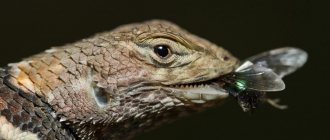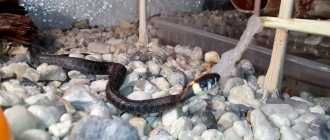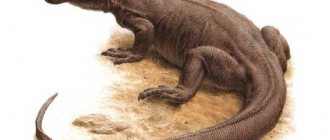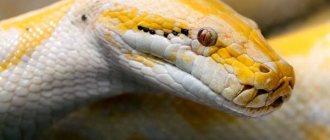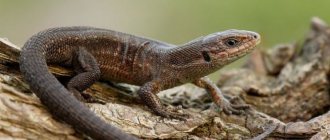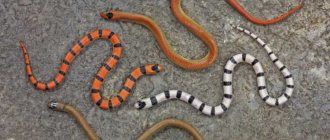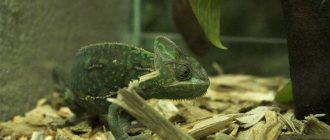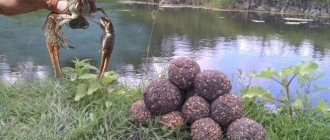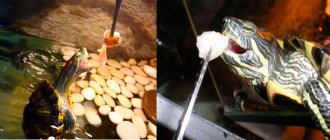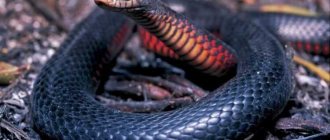Many people are scared of snakes. At the same time, it is simply impossible not to note their features and uniqueness. Cold-blooded animals amaze with their behavior, original method of movement, the strength of the toxic substance and their unusual appearance. Snakes belong to the chordates of the animal world. Reptiles are included in the order Scaly, suborder snakes. The existence and well-being of cold-blooded animals is greatly influenced by the ambient temperature. The study of snakes reveals the unpredictable traits of reptiles and is gaining a growing audience that cannot help but fall in love with this population.
Who do snakes eat? Why do snakes eat themselves?
This rather large snake (sometimes exceeds 2 m) hunts mainly large and strong pit snakes, which are deadly to humans. In a sharp lunge, the mussurana firmly grabs its prey by the neck behind the head and with lightning speed wraps its body around it. After this, without unclenching its jaws, but gradually moving them, it captures the victim’s head in its mouth and gradually begins to swallow it. The mussurana itself is also poisonous, and its poison, although it does not kill the prey, but noticeably weakens it. At the same time, the poison of the victims has practically no effect on the predator. A snake that hunts other snakes gains one undeniable advantage: swallowing a long, narrow and smooth creature is certainly much easier than some spherical egg or angular toad.
Human
The largest snakes - the reticulated python and anaconda - can attack humans, and in history there are unique cases of people being strangled by them. Python attacks killed a 14-year-old boy and an adult woman, and an anaconda once killed and swallowed a 13-year-old boy. But all these cases are so unique that the title of “man-eaters” should not be attributed to snakes.
HOW AND WHAT DO SNAKES EAT. FEEDING SNAKES WITH LIVE FOOD OBJECTS. 18+
Are you crazy commercials with the funny cats? Then I suggest You to see the contents of this section here are different funny videos with Your favorite Pets. Here you will be able to find something that will lift your mood and make Your day. However, here you can find not only a variety of the fun and touching scenes with animals, but also interesting information about the animal world.
As mentioned above, there are a lot of funny commercials with Pets. So many of them only for the reason that today virtually every owner of a pretty pet, tries to shoot the video with him and upload to the network. Someone does it for some earnings, someone just to share, but not the essence, the important thing is that these videos came to us. There are hundreds, thousands of funny videos of cute, cute cats, raccoons, dogs and other mammals that can live in Your apartment. Most often these videos are short and have one brief moment where the animal did something funny by accident. Sometimes you can find even a whole thread with seals, which are cute look at the camera, funny maucat or funny fall from a small height.
Often you can find and video, which animals are trained from early childhood, and now they can perform a very complicated, seemingly inaccessible to the animals tricks. For example, a trained mouse can pull out money from her purse and carry them to the owner. Or a trained cat brings Slippers, if she were a dog, and the dog walks on his front paws no worse than a circus gymnast. Various funny and not so the moments can be seen in videos of this type.
Sometimes there are people who give birth to very unusual Pets and show room life all over the Internet. The same Youtube is full of different videos with exotic predators and animals that now live in simple apartments. However, some are trying to make insects, creating in your home a real terrarium.
First you need to catch the prey
Before starting a meal, the snake needs to go hunting and catch prey. A predator can sit for hours in a secluded place, waiting for an opportunity. As soon as the desired object approaches the shelter, the snake sharply throws its body forward and inflicts a fatal bite.
Non-poisonous individuals independently find prey, crawling into secluded places, nests, and rodent burrows. At any opportunity, the snake rushes at its prey, wrapping its body around it in a spiral, with rings. The muscles of the predator's body are so strong that they can easily strangle someone who falls into its deadly embrace.
The viper is the most dangerous snake in our latitudes
These people buy cells, insects and begin to dissolve them, not forgetting to use the camera important moments in the life of the new colony. Most often give birth to harmless ants, but sometimes there are the only ones who buy and grow at home poisonous spiders, beetles, and other exotic and dangerous creatures. In addition, they love to pit these poor insects and see who of them will survive after a fierce battle in an artificial box. If you are interested to look at something unknown, such a video is clearly for You!
In Addition to a variety of funny content here you can find interesting and even informative things. Smart people who have devoted their entire lives to the study of the animal world, will tell You about how wild animals live. You will know what feeds one or the other predator, as different types and how they behave in their natural environment. In addition there can be and interesting tips that will help you to find a common language with Your favorite pet or recommend what breed it is better to have and how to take care of it.
News and society
Who are snakes?
Snakes are usually called a peculiar group of animals representing the class of reptiles, or reptiles. They are represented by one single order - Scaly. They are all predators. However, among the huge variety of these animals, there are both harmless and cute creatures, and creatures that pose a serious danger to other animals and, of course, people.
How many years does a snake live in captivity?
It is commonly believed that in captivity, with proper care, some species of snakes can live for half a century. Indeed, not so long ago a dark python ended its days at the Moscow Zoo. He lived for about 50 years and reached a length of more than 5 meters. A royal python can live the same amount of time in a terrarium. But it is believed that these are the longest-living record holders among snakes kept in captivity.
Moreover, these data were not officially recorded. But here is the generally known data on various types of snakes. They are quite old, but these are definitely not rumors.
So, the record for longevity among snakes belongs to a boa constrictor named Popeye. He died at the Philadelphia Zoo in 1977 and lived just over 40 years.
How long does an anaconda snake live? It is known that one of the anacondas at the Washington Zoo lived for 28 years.
The average lifespan of a snake is from 10 to a maximum of 20 years. You can also find out how many years a cobra snake lives from quite reliable sources. These largest venomous snakes lived in captivity for more than 30 years, and grew throughout their lives, resulting in the body length of individual specimens being more than 5 and a half meters.
Other species of cobras live from 12 to 15 years in captivity; the American chicken beetle can live 18.
And of course, you need to understand that we are talking about keeping an animal in captivity, and captivity presupposes comfortable conditions for the specimen, a nutritious diet, the absence of enemies, the ability to lead an existence typical for this species and veterinary care. As a rule, all this is possible in a zoo.
But these days, there are more and more hobbyists who keep snakes at home. But if not properly cared for, a snake (for example, a snake that is recommended for beginners) will not last even a couple of months. And if done correctly, it will live up to two decades and, perhaps, will delight the novice serpentologist with its offspring.
Why do they need poison?
As we noted above, non-venomous snakes are represented by a larger number of species than poisonous ones. However, one should not write off snakes as dangerous to humans. As the name implies, venomous reptiles use a certain toxic substance - poison. They need it primarily for hunting this or that victim, and not for self-defense, as is commonly believed. The poison of some of them is so toxic that it can easily kill a person. That's why snakes in nature are real slithering deadly weapons!
Contents of the terrarium
One terrarium will not be enough to keep a snake. The terrarium must contain several mandatory attributes.
HEATING: The snake must have heating in its terrarium. As mentioned earlier, it is installed on one side of the terrarium, creating a warm corner or heating point. For this purpose, mirror lamps, incandescent lamps, thermal cords and thermal mats are used. The temperature in a warm corner is different for all snakes, but for almost all it is within 30-35 degrees. The cold corner should be at room temperature (23-26). The heating should be on for approximately 11-12 hours a day - at night the heating is turned off. The night temperature can drop several degrees below room temperature, thereby ensuring daily temperature fluctuations. If the house is very cold at night, consider providing enough nighttime heating to keep the snake comfortable.
Repti Zoo sticky thermal mat
WATER/HUMIDITY: Another must-have item in a terrarium is a water bowl. The water in the drinking bowl should always be clean and fresh. It needs to be changed 2-3 times a week. The size of the drinking bowl should be such that the snake fits there completely when curled up. The drinker also maintains a certain level of humidity in the terrarium, and the denser the surface, the higher the humidity. Also, to increase humidity, the terrarium is periodically sprayed. The level of humidity for different species can vary significantly, so check the humidity for a specific species in articles on their content or look for weather conditions in the snake’s natural range - this is the most reliable option
Stone drinking bowl for reptiles Simple Zoo
SUBSTRATE/BEDDING: The snake should not be placed on bare glass or plastic. There are a number of practical types of substrate, such as paper towels, napkins, newspaper, moss, sawdust, coconut chips, that can suit your terrarium. The first three are the cheapest and most convenient option - it’s easy to clean the terrarium, but it doesn’t hold moisture well and doesn’t look aesthetically pleasing. The latest options look more beautiful and are also quite easy to clean, but the price is higher. Although, if you have the opportunity to go out into the forest and if you properly disinfect it, you can collect tons of natural, beautiful filler. You can also combine substrates, for example, put a towel or dry bark on the warm, dry part of the terrarium, and sphagnum moss on the wet, cold part - it retains moisture very well.
These are perhaps all the attributes that must be contained in a terrarium. There are only three of them: drinking bowl, heating and substrate.
It's also worth noting that some snakes require shelter in order to feel safe. Whether to install shelters or not, look and decide for yourself. Sometimes it is necessary, sometimes it is unnecessary. There is another one that applies to tree snakes - snags, branches. Many and at different levels of the terrarium. Arboreal and semi-arboreal snakes can also be given a couple of snags and branches - many of them will willingly settle on top of one of them.
Snake skin
As a rule, the entire body of a snake is covered with skin or scales. There is a very important point to make here. Contrary to popular belief, the skin of these creatures is absolutely dry, and not slimy and moist, as is popularly believed. Perhaps such confusion arose due to the conditional similarity of snakes with slippery and wet earthworms.
The vast majority of snakes have a specific skin structure on their belly. They need this for better grip on the surface on which they crawl. Some people believe that these reptiles do not have eyelids. This is wrong. They are there, but not like many animals. The eyelids of snakes are represented by transparent scales and are always closed.
Snake Reproduction
Cold-blooded animals like to be alone. But during the mating season they become very friendly and loving. The “dance” of males can last many hours before the female gives consent to fertilization. Most snakes are oviparous animals, but there are some species that give birth to live young. A snake clutch can reach 120,000 eggs (this process is influenced by the habitat and type of reptile).
Sexual maturity in snakes occurs in the second year of life. The female is searched for by smell, after which the males wrap themselves around the body of the chosen one. Surprisingly, parents of newborns do not pay the slightest attention to them.
Are there white snakes?
They exist. But not as an independent species, but as genetically unique individuals. In other words, a white snake is the most common albino. The most famous are Californian albinos. Scientists say that they may soon occupy about 70% of the total inhabited territory in the Canary Islands.
The white snake is a rather rare specimen in nature. It can be found in any of these reptile families - from the harmless grass snake to the black mamba or king cobra! These albinos should not be confused with milk snakes, since the latter have completely different body colors.
What foods are suitable for pet snakes?
To prepare your own feed, you can prepare the following:
- Mice or rats. You can buy them in a special store, or you can breed them yourself.
- Choose live or frozen food for your snake.
- Choose the right size food that matches the size of the reptile itself.
- Provide your pet with water. Snakes love to be completely submerged in water.
What do snakes eat?
As we noted above, snakes in nature feed on almost everything that moves. They professionally hunt frogs, rats, shrews, mouse-like rodents, grasshoppers, birds, antelopes, wild boars, crocodiles, etc. When the snake begins to swallow the victim, it spreads the so-called branches of the lower jaw quite widely. If the prey is large, the reptile can swallow it within an hour.
For example, large snakes (reticulated python, anaconda, water boa) first strangle their prey using the rings of their body, and only then swallow them whole and gradually. One of the most favorite delicacies of these reptiles are bird eggs. Small snakes, on the contrary, do not use strangulation techniques, much less wait for their prey to die. They eat small vertebrates and invertebrates while they are still alive.
It is not for nothing that they say that every exception confirms the rule. So among snakes there are exceptions. Although they eat everything, some of them are very picky about what they eat. For example, the North American green snake eats only spiders, caterpillars, fish and birds. This creature would never touch mice or lizards for anything in the world. And small water snakes devour only frogs and fish, and prefer not to touch land mammals at all.
Characteristics and structure of snakes
Until recently, science knew of 3,200 species of snakes, and only 410 species were poisonous. The most interesting and unusual feature of cold-blooded animals is their unique body structure. An adult can grow up to nine meters in length. The smallest snakes grow up to 10 cm. The same fluctuations apply to the weight of representatives of the squamate order, starting from 10 g and reaching 100 kg. The main distinguishing feature of males is their long tail; they also grow smaller in size.
The variety of body shapes is simply amazing. There are individuals that have a long and thin body, or, conversely, a short and thick body. Those snakes that live near the sea have a flattened appearance and often resemble a ribbon. The skin of cold-blooded animals is predominantly dry, completely covered with scales or peculiar scutes. In different parts of the body, the surface is different, for example, on the sides and on the back the scales are small and resemble tiles (as they overlap each other). The belly of most snakes is “studded” with wide semi-circular plates.
The snakes' eyelids are motionless and seem to be able to hypnotize their prey. Reptiles never blink and even sleep with their eyes open. The unique structure of the skull allows even the smallest individuals to open their mouths enough for a small rabbit to fit into it. This is because the upper jaw is connected to neighboring bones and is movable, while the elements of the lower jaw are connected by a ligament that stretches.
Due to the unusual body, the structure of the organs is also unique: they are all elongated and elongated closer to the head. The skeleton has a total of about 200-400 vertebrae, each of which is movable and connected by ligaments. The snake glides along the ground due to the movement of the scutes located on the belly. Thanks to the keratinized layers of the epidermis, cold-blooded animals move quickly without difficulty.
Despite all the features of snakes, reptiles have poor eyesight and hearing. In return, nature rewarded them with an excellent sense of smell and touch. An important role in orientation in space is played by the tongue, which is forked at the end. Many researchers call it a “sting.” Opening its mouth, the snake catches the air with its tongue and various particles and elements of the atmosphere stick to it, then the reptile brings the organ to a certain place located in the mouth and smells and tastes.
In most cases, snakes use their venom for self-defense, and this is also one of the ways to kill the victim.
Lifestyle
All snakes are predators, many of them can capture prey that is significantly larger in size than the snake itself. Typically, small and young snakes feed on worms, mollusks, insects, some on amphibians, reptiles, birds, fish, rodents and larger mammals. Several months may pass between two meals.
In most cases, snakes lie motionless, lying in wait for prey, and then rush at it with amazing speed and immediately begin to swallow. Poisonous snakes bite and wait for the venom to take effect, while the boa constrictors wrap themselves around the victim and strangle it.
There are several ways snakes can move. Usually the snake bends in a zigzag manner and is pushed away by parts of its body adjacent to the ground. In the desert, snakes use the so-called “lateral move”: the body touches the surface at only two points, the front part of the body is moved sideways (in the direction of movement), then the back part is “pulled up”, etc. The “accordion” method of movement is distinguished by the fact that the snake’s body is gathered into tight loops, and the front part of the body moves forward. Large snakes move in a straight line with a “caterpillar gait,” clinging to the soil with their shields and straining the muscles of the abdominal part of the body.
Snakes are distributed everywhere, with the exception of New Zealand and small oceanic islands. They mastered life in the forest, steppe, desert, underground and even in the sea. The largest number of species lives in the warm countries of East Asia and Africa; over 50% of Australia's snakes are venomous.
Some snakes, under favorable conditions, can bear offspring up to several times per season, while others do not reproduce every year (for example, the Caucasian viper). The bamboo keffiyeh, found in India and Pakistan, can reproduce all year round. Like most animals, snakes have their own “mating rituals” of varying degrees of complexity. After mating, females are able to keep the partner’s sperm in an active state for quite a long time and do not need to meet the male again for new fertilization.
Usually the cubs hatch from eggs, but viviparity is also widespread (typical of sea snakes, boa constrictors, and vipers). The female develops a placenta through which the embryos receive oxygen, water and nutrients. Sometimes the female does not have time to lay her clutch, and the cubs hatch inside her reproductive tract. This case is called ovoviviparity (vipers, copperheads).
One clutch contains an average of 10 eggs. Embryonic development is dependent on temperature, so snakes ensure that the nest temperature is maintained at a high temperature and also protect the eggs from drying out.
Snakes typically live 5–10 years, with some individuals living up to 30–40 years.
Many birds and mammals (storks, eagles, crows, hedgehogs, representatives of the order Carnivores and even pigs), and even other snakes feed on snakes.
What do snakes eat?
All snakes, without exception, are carnivores. Their diet includes various types of animals, the size of which depends primarily on the size of the predator itself. The main food of snakes is frogs, rodents, lizards, their own relatives, including poisonous ones, as well as some types of insects. The ability to climb trees gives snakes the opportunity to destroy bird nests by eating chicks or eggs.
Snakes do not feed every day, and if they fail to catch prey, they can starve for a long time. If water is available, snakes can go without food for up to several months.
All snakes track their prey patiently, hiding among the leaves of trees, or on the ground, along paths leading to a watering hole. Snakes swallow prey from the head, not from the tail, fearing the sharp teeth of the victim, who may still be alive. Before swallowing a victim, non-venomous snakes squeeze it with the rings of their body so that it cannot move.
The duration of digestion of the victim depends on its size, the state of health of the snake, the ambient temperature and usually lasts from 2 to 9 days. Digestion requires higher temperatures than other life processes. To speed up the process, the snake exposes its filled belly to the sun, leaving the rest of the body in the shade.
Hibernation
With the onset of cold weather, approximately in the second half of October - early November, snakes go to winter, climbing into rodent holes, under stones or tree roots, into haystacks, into cracks and crevices. In populated areas, they gather in basements, abandoned wells, and settle along pipes with heating and sewer systems. Winter torpor may be interrupted at times, and then they can be seen on the surface. In the tropics or subtropics, snakes may not hibernate or only sleep for short periods of time.
At the end of March - early April, snakes crawl out of their shelters. The life activity of snakes, as cold-blooded animals, depends on climatic factors: temperature, sunlight, humidity, etc. In this regard, the daily activity of reptiles also changes in different seasons of the year. In spring, they spend all day long under the sun, and in summer, the period of activity occurs in the morning, evening and night hours.
Types and names of snakes with photographs
Snakes are considered to be very diverse animals in terms of species. The names of reptiles are sometimes striking in their number and huge range. These animals belong to the group of reptiles, the order of squamates.
In one snake family there can be a minimum of 8 families and a maximum of 20. Such a discrepancy directly relates to the fact that today scientists have discovered a huge number of new types of reptiles. And therefore it is difficult for them to divide them into any groups.
The most common families are:
- Colubridae
- Blind Snakes
- Aspidae
- Gadyukovs
Many people know reptiles, since these animals were able to colonize most continents over a long period of time. Many snakes prefer hot climates, therefore, they live exclusively near the equator or in tropical countries. Toward the poles, the number of reptiles decreases significantly. And only the common viper can live in cold regions. Reptiles can live in almost any place, even in the oceans. Many colubrids and vipers dig holes and like to live underground.
Reptiles
The reptile lives in deserts, steppes, mountains, near rivers and lakes. Snakes are interesting animals, as they have an original appearance and move in a unique, even unusual way. The reptile has amazing features - a method of behavior and the ability to release poison. That is why they never cease to attract the attention of mankind.
There are a huge number of myths about snakes, which often cause great fear in people. Currently, scientists have been able to discover approximately 3,000 species of snakes. Among them there are both poisonous and non-poisonous.
Reptiles are non-venomous
- Already ordinary. This species is most often found in Eurasian countries. There is a distinctive mark on his head - these are 2 light spots. It lives in places where there are bodies of water. The snake loves to bask in the sun and is also able to move through trees. The reptile is also capable of swimming, diving, and remaining underwater for a long time without air.
Already
- Reticulated python. This reptile is considered the longest among its relatives. In nature, there was an individual whose length was approximately 12 m. The python lives in Asia. It can catch prey by moving through the trees, but at the same time loves to swim in the water.
Python
- Anaconda. This representative of reptiles is considered the heaviest. The weight of the animal sometimes reaches 200 kg. The anaconda is a fairly strong snake and most of its body is muscle tissue. The reptile's nostrils are closed with valves, so once upon a time in ancient times people called it a “water boa.”
Anaconda
Reptiles are poisonous
- Viper. This snake is more often found in nature than others. It lives, as a rule, on the territory of the Russian Federation and in some European countries. The viper likes to live with a couple, occupying a territory that is up to 4 hectares.
Viper
- Sandy efa. This snake has the most valuable venom from which people make serums and medicines. Efa is small in size, when it attacks a victim, it begins to move in the form of rings and hiss.
Efa
- King Cobra. It is considered one of the most poisonous reptiles. The cobra can also be called the largest among the poisonous representatives. The reptile loves to eat snakes of other varieties. It has so much poison that even a large elephant can die because of it.
The most poisonous
- Black Mamba. This individual is considered the fastest. The reptile is arboreal, and therefore moves through trees quite quickly. Attacks its own victims without warning.
Mamba
Despite the fact that snakes can only cause fear and panic in people, many decide to have such an animal at home. Some species may already disappear today, therefore, they need to be protected and not used for leather production.
Snakes eating snakes
The most famous cannibal is the most dangerous among all snakes - the king cobra. Its diet, in addition to small mammals and amphibians, also consists of its own relatives. The king cobra happily feasts on smaller snakes. She first kills the victim with poison or by strangulation, after which she swallows it.
Not long ago, scientists discovered another fact of cannibalism among snakes, in particular rattlesnakes. The fact is that these creatures eat their own offspring. Scientists believe that this phenomenon cannot be attributed to the pathology of rattlesnakes and should not be considered as infanticide, because they feed exclusively on dead cubs. That is, some rattlesnakes are not only cannibals, but also scavengers.
Many people do not believe that cannibal snakes exist in nature. However, there is so much that doesn’t exist in nature! Snakes eating snakes is not uncommon or even exceptional. This is a pattern. If, for example, lizards can eat their young, then why can’t snakes eat their own relatives? Even someone well known to all of us can, on occasion, feast on... a viper! This is natural selection.
Comments
Similar materials
News and Society Does a two-headed snake exist? Two-headed albino snake
In the East, many believe that the one who knows the snake knows the world and the secrets of its creation. The snake amazes the imagination with its exceptional behavior and structure. These creatures live on the ground, in trees,...
Spiritual development Snake-Aries Woman: characteristics of the sign
An unprecedented phenomenon, namely a cold flame, is what the Snake-Aries woman is. The characteristics of this personality are incredibly interesting, as is communication with her. Each of us from a certain point of view...
Spiritual development of Taurus-Snake-man: characteristics, compatibility, character traits and interesting facts
The Taurus man, born in the year of the Snake, has a lot of qualities that can help him become successful in many areas of life. After all, such a person will be distinguished by considerable hard work, attractiveness, loyalty and practicality...
Spiritual development Virgo-Snake (male): characteristics, compatibility
Zodiac and eastern horoscopes can tell a lot about each person. Moreover, the most accurate characteristics can be obtained by considering them together. So, for example, the Virgo-Snake is a man who is quite self-confident...
Suzuki Liana cars: owner reviews, disadvantages, technical characteristics and features
The Suzuki Liana is a compact city car that at one time attracted considerable attention. This model appeared in 2001 and marked the emergence of a new body type - ...
KrAZ-6510 vehicles: brief characteristics of the vehicle
The Kremenchug automobile enterprise was built more than 80 years ago and was initially engaged in the production of aviation equipment. However, during the Second World War, many of the plant’s buildings were completely destroyed and...
Cars Crawler mini tractor: brief characteristics and recommendations
Subsidiary farming literally obliges a modern person to think about purchasing specialized equipment, the use of which, in turn, will significantly simplify the performance of such tasks...
Nissan Avenir cars: a brief description of two generations of the Japanese station wagon
The Nissan Avenir is a station wagon that has been produced by the Japanese automaker for 15 years. The first model was released in 1990, and the last one in 2005. This model is based on the &…
Cars Is it possible to mix oils from different manufacturers? Characteristics of motor oils
Almost all car enthusiasts know that the technical condition of the car depends entirely on the quality of the engine oil and the frequency of its replacement. According to the instructions, the car needs it every 7-10 km. Only …
Business Industry of Poland: brief description of key industries
Even in primitive times, the Poles began to engage in pottery, weaving, yarn and farming. During the Middle Ages, craftsmen independently made industrial products by hand. Only after separating the craft...
How can you tell if a snake is fat?
Here are some signs that your snake is overweight:
- A sharp transition from the body to the tail is visible;
- Folds are visible, the skin seems to be stretched in places, and the second part of the body looks like an “accordion”. This is a clear sign of obesity, and advanced obesity.
- The snake is flabby; in addition to hard muscles, it has soft sides even in a tense state of the animal.
If these signs sound familiar to you, it's time to put your snake on a diet. This does not mean that you need to stop feeding the snake - just increase the intervals between feedings and give food one and a half times smaller. Turn to dietary meat - chickens, quails.
In contrast, we can say that the snake should not be too thin. If the animal’s spine protrudes (unless this is a feature of a particular species), or the ribs are clearly palpable, or the skin on the sides is curled, and the pictures on the Internet do not at all look like your pet, you should feed a little more.
RULE #8. You need to reduce or increase the amount and size of food GRADUALLY, over several meals.
So our guide on the rules of feeding snakes has come to an end. Although it looks big, there is nothing complicated about it. However, these rules can significantly extend the life of your pet!
P.S. Some photos are taken from the Internet for informational purposes only.
Symptoms of a poisonous snake bite
A venomous snake bite causes severe and prolonged pain, swelling, and bruising at the site of the bite. Victims complain of difficulty breathing, dizziness and palpitations. In severe cases, there is a disturbance of consciousness, vomiting, and a decline in cardiac and respiratory activity. There is a drop in blood pressure, agitation, convulsions, and pinpoint hemorrhages. However, many of these symptoms can appear simply from fear, so do not panic, but remember - you definitely need qualified medical help.
If, nevertheless, a snake bites a person, the first thing to do is call the rescue service (112) or call an ambulance (03).
Terrarium
Perhaps the most important aspect of keeping snakes (and all reptiles in general) at home is the presence of a terrarium. “Yes, a terrarium is a must,” and don’t refer to “a friend who has kept a tiger python in a basin under her bed for five years and he feels good there” - this is wrong! The snake needs very specific conditions and then it will live a long, healthy life.
Terrarium 60*45*90 PetPetZone
So, the first point in choosing a terrarium is choosing its type. Terrariums come in three types: horizontal, vertical and cubic. We select the type of terrarium depending on the animal’s lifestyle - arboreal snakes (boigs, green pythons) need a vertical terrarium, semi-arboreal species (thin-tailed snakes, Cuban boas) a cubic type terrarium is quite suitable, and terrestrial snakes (milk snakes, royal pythons) will suit a horizontal terrarium type. We've decided on the type, now we need to choose the size. You already know the approximate size of your snake when it grows, but if not, the Internet will help you))) Based on this size, the dimensions of the terrarium are selected. But it is worth remembering that the terrarium should allow for a temperature difference of approximately 7-10 degrees. One corner of the terrarium should be heated with a thermal cord, a thermal mat or a simple incandescent lamp, while the other should be at room temperature (cold corner). The size of the heating spot should be minimal, on which the snake, curled up, would fit completely. Thus, for a terrestrial snake, the size of the terrarium is calculated something like this: the length is half the length of an adult snake, the width is a third or a quarter of the length of the snake, the height is not so important. For tree dwellers, the same guidelines are used, only instead of length there will be height. For example, for an adult maize, you can plant it in a terrarium with a bottom area of 60 x 40 cm, the height is not so important, 15 cm is enough. IMPORTANT!' 'You shouldn't put a small snake in a large terrarium right away' - this can provoke stress, expressed in refusal of food, nervousness and other signs. Increase the size of the terrarium as it grows. I advise you to use plastic containers for growing food and for things that are abundant in hypermarkets, such as Auchan - both cheap and practical)
Kit for the imperial boa constrictor “Minimum”
First aid for a snake bite
When bitten by a poisonous snake, severe pain, a feeling of heat, nausea, vomiting, muscle weakness, drowsiness, cold sweat, and increased body temperature occur. These are the symptoms of a poisonous snake bite. Quick transportation of the victim to the hospital within an hour and a half will save the person’s life. If you called specialists (112, 03), try to provide minimal assistance to the person who was bitten.
The minimum help for someone bitten by a snake is as follows:
- do not worry yourself and calm the bitten person;
- examine the wound and make sure there are signs of poisoning;
- lay the victim down and ensure immobilization of the limb (suspension) without applying a pressure bandage;
- give plenty of fluids;
- if help does not arrive soon in the first 20 minutes after the bite, you must try to suck out the poison;
If it was not possible to call specialists, you must independently take all measures to alleviate the condition of the person who was bitten by the snake and transport him to the hospital. If you have a first aid kit and the skills, providing first aid in case of a snake bite will not be difficult.
snake poison
What is snake venom? This is saliva produced by the salivary glands of poisonous individuals. Its healing properties have been known for hundreds of years: with the addition of snake venom, pharmacists make homeopathic preparations, creams, ointments and balms. These remedies help with rheumatic joint diseases and osteochondrosis. However, encountering a poisonous bite from this reptile in nature can be not only unpleasant and very painful, but also deadly.
What to do if bitten by a snake
- immediately after the bite, place the victim in a comfortable and safe place, ensuring complete rest. It is important to remember that independent movement of a person when bitten by a snake is extremely undesirable. In order to slow down the spread of poison in the body, limit the mobility of the affected organ. If you are bitten on the arm, secure it in a bent position.
- in the first seconds after a snake bite, pressing with your fingers, open the wound and begin to vigorously suck out the venom with your mouth, spitting regularly. If there is little saliva or there are wounds on the lips or in the mouth, you should put some water in your mouth (water dilutes the poison). Suction must be carried out continuously for 15 minutes. This allows you to remove 20 to 50 percent of the poison from the victim’s body. For the person providing assistance, suctioning out the poison is not dangerous, even if he has wounds or abrasions in his mouth.
- after the snake’s venom has been sucked out, the bite wound must be disinfected and a sterile bandage applied, which should be periodically loosened as swelling develops so that it does not cut into the soft tissue.
- If you are bitten by a snake, you can use the following medications:
- painkiller (analgin).
- antihistamines (antiallergic - diphenhydramine, suprastin, etc.).
- drugs that support the cardiovascular system (validol, valocardine, etc.).
- Give the victim more tea, broth or water (it is better to avoid coffee as an stimulant). This will help remove the poison from the body.
- try to immediately deliver the victim to the nearest medical facility, transporting him on a stretcher.
- Monitor the patient’s condition: alarming symptoms are shortness of breath (heart problems), burning in the throat, hoarseness (swelling of the larynx). If necessary, perform prolonged artificial respiration and cardiac massage.
If the snake dies in the process of being bitten, it is advisable to take a lot of precautions (without touching it with your hands), put it in a bag (preferably several) and take it to a doctor to determine the species of the snake.
Where do they live, what do they eat, how do snakes reproduce in nature?
Over a long period of evolution, snakes were able to colonize almost every continent except Antarctica.
In nature
Reptiles can live in a wide variety of environments.
But they prefer:
- Forests, forest-steppes
- Savannah
- Desert places, mountainous areas
Snakes penetrate rock crevices, swim, and climb trees. They often like to get into places where people live. They are found in areas of villages, summer cottages, city parks and squares.
Since snakes are cold-blooded animals, they always sense changes in the weather. When cold weather sets in, reptiles go into hibernation. In winter, they crawl to secluded, comfortable places.
In nature
It could be:
- Rodent mink.
- A hollow or void among the roots of trees.
- Home basement or shed.
When snakes sleep in winter, their vital processes slow down, even their heart rate. Animals sleep for an average of 3 months. It all depends on the type of reptile and the climate of the region. When the weather changes and begins to warm up, snakes wake up and leave their hiding places.
Captive
To keep a snake in captivity, it is necessary to carefully study the lifestyle of these animals and provide them with the necessary conditions.
In the zoo, reptiles live in comfort, in conditions that are as close to natural as possible. The snake's house is called a terrarium. It has everything that snakes are familiar with.
Namely:
- Sand
- Tree branches
- Stones
- Moss
- Various vines
The terrarium maintains the required temperature at all times. The humidity and light necessary for the snake are also present here. Reptiles eat what they like to eat in the wild. They are often fed small rodents.
Snakes overwinter in the zoo just as they do in the wild. Many zoos are trying to maintain a species that is disappearing. Consequently, the facility’s employees make a lot of efforts to provide the animals with the proper conditions where they can reproduce and increase the population.
The main goal of nature reserves and national parks is to preserve and restore rare species of reptiles. The lifestyle of these animals here is the same as in the wild. Snakes can hunt, rest, and hibernate.
Captive
- In the circus, snakes live in terrariums, but they are not always provided with the necessary conditions. Sometimes, due to strong light, noise, and violations of sanitary standards, disastrous consequences arise. In circuses that move, reptiles do not live long. Many states have decided to abandon such circuses.
- At home, keeping snakes requires special conditions. Keeping reptiles requires an ideal sized terrarium, lighting, heating, and suitable humidity. Many animals need to be sprayed periodically to prevent their skin from drying out. It must be remembered that reptiles are considered carnivores. Therefore, they require a proper diet, consisting, for example, of rodents.
“Wintering,” even at home, is a fairly important stage for snakes. So that animals do not stray from their natural biological rhythm, they need to be helped to hibernate. The temperature in the terrarium decreases over time, and daylight hours also decrease.
Reptiles eat a variety of animals in their diet. The size of the prey depends on the predator. But most of all, these animals love to eat rodents, lizards, their own relatives, even poisonous snakes. Some snakes have preferences for different types of insects. Due to the fact that reptiles can climb along tree branches, they often destroy nests, eat eggs or even small chicks.
Creeping reptiles do not feed every day. And, if they manage to get a victim, they starve for a long time. If snakes live near a body of water, they generally do without food, that is, they starve for several months.
Each snake stalks its own prey very patiently. The animal hides among the leaves or on the ground, near paths that lead to water. The snake swallows its own prey, starting from the head part, because it is afraid of the teeth of the prey. Snakes, which are considered non-venomous, before swallowing food, squeeze the victim with the coils of their own body so that it cannot move.
Food is digested differently in the snake's stomach over time. It all depends on the health of the reptile and the temperature around it. This process is extended for a minimum of 2 days and a maximum of 9 days. Digestion requires a higher temperature than other life processes. To speed up digestion, the animal lies with its belly facing the sun and hides other parts of its body in the shade.
Snake
Snakes can reproduce in 2 ways:
- Some species, for example, viper, lay eggs in which embryos have not yet developed. Further development of the fetus occurs outside the mother's body.
- Vipers and copperheads are considered ovoviviparous. The eggs, until the embryos are fully formed, are in the female’s body.
Pregnant snakes sometimes go hungry. They become sedentary and cautious. Heavy animals are not able to instantly rush at the victim, and therefore they are mainly found in secluded places.
Vipers, for example, give birth in late summer or early autumn. The number of newborn cubs can reach up to 8 individuals. In some situations, up to 17 children or more are born. Small reptiles have the same behavior as adult snakes. They are able to move, hiss, and bite during defense, releasing a little poison during the bite. Small vipers feed only on insects. They like locusts, grasshoppers, bugs and so on.
When snakes reach sexual maturity (at about 2 years of age), they mate. The male tries to find his mate by smell. When he finds it, he wraps himself around the neck of the chosen one and rises high above the ground.
Sometimes non-venomous snakes become aggressive during mating season because they become very excited and agitated. Mating of reptiles is carried out in a ball, but immediately after the process the animals disperse and are never seen again after that. Parents show no interest in small cubs.
Snakes can be aggressive
To lay eggs, the snake chooses the most comfortable place, for example, the roots of bushes, cracks between stones, old stumps. For a young “mother” it is important that the corner is quiet and secluded. The eggs that the snake lays develop rapidly. Only a couple of months pass and small reptiles are born. The emerging snakes lead an independent lifestyle. On average, a snake can live up to 30 years.
Viper snake. Viper lifestyle and habitat
As a rule, they receive a bite in the area of the nasolabial triangle, that is, when they sniff a snake. Swelling quickly develops and the symptom of dysphagia occurs when the dog is unable to swallow food or water. In hunting dogs, symptoms of poisoning spontaneously disappear after about 6 hours, which does not exclude further complications from the bite, usually associated with the kidneys. In large dogs, a severe clinical picture of poisoning may develop; the animals lie down, groan, pathologies of the heart, murmurs, wheezing, and pulmonary edema may be detected. Treatment, of course, should be carried out in a hospital. As a rule, we have about 5-6 hours to deliver the animal to the hospital.
What do turtles eat?
Most adult turtles prefer vegetation to meat. However, this is not the case for hatchlings and juveniles, who need a lot of protein to form their shells, so they are more likely to feed on larvae, snails and small insects. Some sea turtles feed on jellyfish and marine invertebrates, while others prefer algae.
By the way, you can cause diseases or cause deformities in the shell of your pet turtle if you give it too much animal protein!
Poisonous snakes of the Moscow region
There are only two species of snakes living in the Moscow Region: the common snake (Natrix natrix) and the common viper (Vipera berus). The first is naturally not poisonous, and the second is poisonous, although the poisonousness of vipers is somewhat exaggerated. The mythical copperhead, which is actually a non-venomous snake, is practically never found in the Moscow region. Thus, in the Moscow region, the common viper is the only species of poisonous snake.
Where in the Moscow region are there the most snakes? In the Moscow region, the most snake-filled places are considered to be the Savelovskoye direction, Konakovo, Verbilki. Also in the Shatursky direction, in the Dmitrovsky district. There are 119 kilometers between platforms and Tempy. As for the rest of the Moscow region, vipers can be found everywhere, but they prefer specific biotopes.
Where does the common viper live? In the Moscow region, the viper lives in mixed forests with swamps or overgrown burnt areas, the banks of rivers, lakes or streams. Most often, the viper can be found in the burrows of various animals, in stumps, and bushes.
How to identify a viper The common viper is a relatively small snake, up to 75 cm long; in the north there are specimens up to 1 m long. The body is relatively thick. The head of the common viper is rounded-triangular, clearly demarcated from the neck; on the upper part there are three large (frontal and two parietal) scutes. The pupil is vertical. The tip of the muzzle is rounded, and the nasal opening is cut in the middle of the nasal shield.
What color is the common viper? The color of the body of the common viper varies from gray to red-brown. Gray snakes with a black zigzag pattern along the spine are considered typical. In fact, with almost the same probability, there are snakes without a pattern, snakes of black, brown, brick, bronze, olive green, gray-blue, and even snakes the color of smoked fish, with a characteristic golden tint.
Common viper, photo universal_naturalist
Where do snakes live?
The distribution range of snakes does not include only Antarctica, New Zealand and the islands of Ireland. Many of them live in tropical latitudes. In nature, snakes live in forests, steppes, swamps, hot deserts and even in the ocean. Reptiles lead an active lifestyle both during the day and at night. Species living in temperate latitudes hibernate in winter.
Poisonous snakes of Russia
The common viper (Viperidae berus) is the most common venomous snake in central Russia. The common viper is distributed in the European part of Russia, Siberia and the Far East (up to Sakhalin).
Another poisonous snake of Russia, the steppe viper (Viperidae ursini), lives in the southern regions of Russia. From above, the steppe viper is colored brownish-gray, with a lighter middle of the back and a black or dark brown zigzag stripe along the ridge, sometimes broken into separate spots. On the sides of the body there is a row of dark, blurry spots. There is a dark pattern on the upper side of the head. The belly is gray, with light specks. For humans, the bite of a steppe viper is even less dangerous than the bite of an ordinary viper. The steppe viper lives in the north of the Lower Volga region (the northern border of the species' range), and in Kalmykia, and in the Ciscaucasia. The steppe viper is very common in the Saratov region, and in the Samara region melanistic steppe vipers are regularly spotted.
The next representative of the poisonous snakes of central Russia is the Caucasian viper (Viperidae kaznakovi) very close to the steppe viper, but is distinguished by a denser physique and a characteristic bright color. Its body is up to 60 cm long. The head is very wide with strongly protruding temporal swellings and a slightly upturned tip of the muzzle. A sharp neck interception separates the head from the thick body. The main color of the body is yellowish-orange or brick-red, and a wide dark brown or black stripe runs in a zigzag pattern along the ridge. The head is black on top with individual light spots. Sometimes there are individuals that are entirely black. The Caucasian viper lives in the Krasnodar region of Russia, the South Caucasus and North-Eastern Turkey.
The common copperhead (lat. Gloydius halys) is the most common species of venomous snakes in Russia of the genus of the copperhead subfamily of the viper family. The color of the upper side of the body of the common copperhead is brown or gray-brown, with transverse dark brown spots, the number of which varies from 29 to 50. Along the sides of the body there is one longitudinal row of smaller dark spots. There is a clear spotted pattern on the head, and on its sides there is a dark postorbital stripe. There are single-colored brick-red or almost black individuals. In Russia, the habitat of the common copperhead extends from the northeastern coast of the Caspian Sea and the mouth of the Volga River in the west to the Primorsky Territory in the east. In the northern Baikal region, the copperhead is numerous in places. The bite of the stink bug is very painful, but usually after 5 - 7 days there is a complete recovery. In the forest-steppe zone (Kursk, Voronezh, Lipetsk region, Volga region, Samara region) Nikolsky's viper , it is always black, and its venom differs from the venom of an ordinary viper, including it contains cardiotoxin. Therefore, its poisoning is more severe. It is always black, but these vipers differ in appearance, and in areas where coniferous or mixed forests are common, Nikolsky’s viper is not present.
Nikolsky's viper, photo Yuri Okhlopkov There is no need to be afraid of poisonous snakes, you need to be prepared to meet them. In this case, not a single snake will spoil your pleasure from outdoor recreation and you will not need recommendations for first aid for a snake bite.
Classification
The suborder Snakes are divided into 8–16 families. Main families:
Sea blinders ( Typhlopidae
). Small snakes with a worm-like body. Adapted to underground life: the head is covered with large scutes, the skull bones are tightly fused, the short tail serves as support for the body when the animal moves in the thickness of the soil. The eyes are almost completely reduced. Rudiments of the pelvic bones have been found in blind blinders. The family has about 170 species, most of which live in tropical and subtropical regions.
Pseudophods ( Boidae
) got their name for the presence of rudiments of the hind limbs, which turned into claws on the sides of the anus. Pseudophods include the anaconda and the reticulated python - the largest modern snakes (can reach 10 m in length). Three subfamilies (Boas, Pythons and Sand boas) include about 80 species. They live in the tropics and subtropics, some species in the arid regions of Central Asia.
To the slate snakes ( Elapidae
) includes more than 170 species, including cobras and mambas. A characteristic feature of slates is the absence of a zygomatic shield. The body is elongated, the tail is short, the head is covered with large, regular-shaped scutes. Representatives of the family lead a terrestrial lifestyle and are distributed mainly in Africa and Australia.
Most sea snakes ( Hydrophiidae
) never go onto land, they are adapted to life in water: voluminous lungs, valves that close the nostrils, a streamlined body and a paddle-shaped tail. Very poisonous. The family includes about 50 species living in the Indian and Pacific oceans.
Viperidae _
) have a thick body with a flat, triangular head, a vertical pupil, well-developed venom glands and a tracheal lung. The pit viper subfamily includes copperheads and rattlesnakes, and the true vipers include vipers, vipers and sand vipers. In total, the family includes about 120 species of snakes.
Colubridae ( Colybridae
) - a family that includes about 70% of modern snakes (about 1,500 species). Snakes are ubiquitous; they are adapted to life in the forest floor, burrows, trees, semi-deserts or bodies of water. They have a variety of food preferences and modes of transportation. The family as a whole is characterized by the absence of a left lung, movable tubular teeth and vestigial hind limbs, as well as a horizontal position of the upper jaw. Based on the structural features of teeth and scaly cover, several subfamilies are distinguished.
